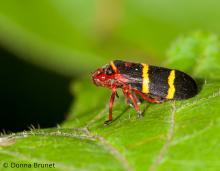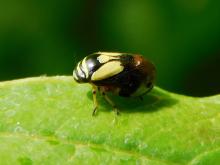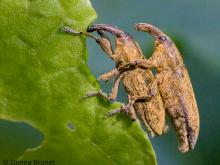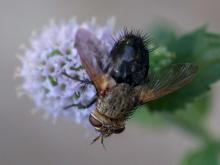Land Invertebrates
Media

Species Types
Scientific Name
8 tribes, with about 23 genera, in North America north of Mexico
Description
Millipedes in family Xystodesmidae often have bright colors that serve as a warning to potential predators that they may secrete foul or toxic substances.
Media

Species Types
Scientific Name
Poecilopompilus algidus and P. interruptus
Description
Poecilopompilus spider wasps provision their nests with orbweaver spiders. They dig nest burrows into the ground and therefore prefer sandy or other workable substrates.
Media

Species Types
Scientific Name
Entypus aratus, E. unifasciatus, E. fulvicornis, and others
Description
Spider wasps in genus Entypus are bluish black and usually have some amount of amber color on their dark, smoky wings. Some species have bright yellow antennae.
Media

Species Types
Scientific Name
Prosapia bicincta
Description
The two-lined spittlebug is a common member of the froghopper family. The two lines may be red, orange, or yellow. Some individuals are all black, except for the red eyes.
Media

Species Types
Scientific Name
Clastoptera proteus
Description
The adult dogwood spittlebug has distinctive black and yellow markings. It feeds on dogwoods, blueberries, and their relatives.
Media

Species Types
Scientific Name
Neoscona arabesca
Description
The arabesque orbweaver is a common orb-weaving spider in Missouri. The coloration is quite variable, but the slanting dark marks on the abdomen help to identify it.
Media

Species Types
Scientific Name
Lixus concavus
Description
The rhubarb weevil has a dusty, bright yellow coating and feeds on rhubarb, dock, thistles, and other plants in the smartweed or buckwheat and sunflower families.
Media

Species Types
Scientific Name
Rabidosa punctulata
Description
The dotted wolf spider has a solid brown stripe running down the middle of the abdomen, seen from above. Like other wolf spiders, females have strong maternal instincts, carrying their spiderlings around on their back until they can be on their own.
Media

Species Types
Scientific Name
About 1,350 species in North America north of Mexico
Description
Tachinid flies are one of the largest families of flies. They are parasitic flies whose larvae are parasitoids of other insects. They look a lot like house flies, blow or bottle flies, wasps, or bees. Many are very bristly.
Media

Species Types
Scientific Name
Neacoryphus bicrucis
Description
The white-crossed seed bug, or ragwort seed bug, has a prominent thin-lined pale X dividing zones of red and black. Look for it in places where ragworts are plentiful.
See Also



Media

Species Types
Scientific Name
Cisseps fulvicollis
Description
The yellow-collared scape moth is more often “orange-collared.” And whether you think it looks more like a firefly or a wasp, it’s still a moth!
Media

Species Types
Scientific Name
Nearly 150 species in North America north of Mexico
Description
Slim, delicate plume moths are instantly recognizable by their T-shaped silhouette, long legs, and muted shades of tan and brown. It can be hard to separate the various species.
Media

Species Types
Scientific Name
Pyrrharctia isabella
Description
Not many people know the adult Isabella tiger moth when they see one, but we’re all acquainted with its caterpillar, the woolly worm, or woolly bear.
About Land Invertebrates in Missouri
Invertebrates are animals without backbones, including earthworms, slugs, snails, and arthropods. Arthropods—invertebrates with “jointed legs” — are a group of invertebrates that includes crayfish, shrimp, millipedes, centipedes, mites, spiders, and insects. There may be as many as 10 million species of insects alive on earth today, and they probably constitute more than 90 percent all animal species.





















